Influence of Ti Layers on the Efficiency of Solar Cells and the Reduction of Heat Transfer in Building-Integrated Photovoltaics
Abstract
:1. Introduction
2. Materials and Methods
2.1. Materials
2.2. PV Module Fabrication
2.3. Methods
3. Results
3.1. Titanium Layer Thickness
3.2. Optical Parameters
3.3. Photovoltaic Parameters
3.4. Temperature Control
4. Conclusions
Supplementary Materials
Author Contributions
Funding
Data Availability Statement
Conflicts of Interest
References
- Barbusiński, K.; Kwaśnicki, P.; Gronba-Chyła, A.; Generowicz, A.; Ciuła, J.; Szeląg, B.; Fatone, F.; Makara, A.; Kowalski, Z. Influence of Environmental Conditions on the Electrical Parameters of Side Connectors in Glass–Glass Photovoltaic Modules. Energies 2024, 17, 680. [Google Scholar] [CrossRef]
- Bodziacki, S.; Malinowski, M.; Famielec, S.; Krakowiak-Bal, A.; Basak, Z.; Łukasiewicz, M.; Wolny-Koładka, K.; Atılgan, A.; Artun, O. Ocena środowiskowa modernizacji systemów energetycznych w budynkach użyteczności publicznej. Energie 2024, 17, 3278. [Google Scholar] [CrossRef]
- Generowicz, A.; Gronba-Chyła, A.; Kulczycka, J.; Harazin, P.; Gaska, K.; Ciuła, J.; Ocłoń, P. Life Cycle Assessment for the environmental impact assessment of a city’ cleaning system. The case of Cracow (Poland). J. Clean. Prod. 2024, 382, 135184. [Google Scholar] [CrossRef]
- Gronba-Chyła, A.; Generowicz, A.; Alwaeli, M.; Mannheim, V.; Grąz, K.; Kwaśnicki, P.; Kramek, A. Municipal waste utilization as a substitute for natural aggregate in the light of the circular economy. J. Clean. Prod. 2024, 440, 140907. [Google Scholar] [CrossRef]
- Kwaśnicki, P.; Gronba-Chyła, A.; Generowicz, A.; Ciuła, J.; Wiewiórska, I.; Gaska, K. Alternative method of making electrical connections in the 1st and 3rd generation modules as an effective way to improve module efficiency and reduce production costs. Arch. Thermodyn. 2023, 44, 179–200. [Google Scholar] [CrossRef]
- The Paris Agreement. Available online: https://unfccc.int/process-and-meetings/the-paris-agreement/the-paris-agreement (accessed on 1 September 2024).
- Kwaśnicki, P.; Gronba-Chyła, A.; Generowicz, A.; Ciuła, J.; Makara, A.; Kowalski, Z. Characterization of the TCO Layer on a Glass Surface for PV IInd and IIIrd Generation Applications. Energies 2024, 17, 3122. [Google Scholar] [CrossRef]
- Biyik, E.; Araz, M.; Hepbasli, A.; Shahrestani, M.; Yao, B.; Shao, L.; Essah, E.; Oliveira, A.C.; del Caño, T.; Rico, E.; et al. A key review of building integrated photovoltaic (BIPV) systems. Eng. Sci. Technol. Int. J. 2017, 20, 833–858. [Google Scholar] [CrossRef]
- Masson, G.; Kaizuka, I.; Bosch, E.; Detollenaere, A.; Neubourg, G.; van Wetter, J.; Lindahl, J. Raport IEA PVPS—Trends in Photovoltaic Applications 2020; The International Energy Agency: Paris, France, 2020. [Google Scholar]
- IEA PVPS Task 15 BIPV, International Definitions of BIPV, Report IEA-PVPS T15–04, August 2018. Available online: https://iea-pvps.org/wp-content/uploads/2020/02/IEA-PVPS_Task_15_Report_C0_International_definitions_of_BIPV_hrw_180823.pdf (accessed on 1 September 2024).
- Kuhn, T.E.; Erban, C.; Heinrich, M.; Eisenlohr, J.; Ensslen, F.; Neuhaus, D.H. Review of technological design options for building integrated photovoltaics (BIPV). Energy Build. 2021, 231, 110381. [Google Scholar] [CrossRef]
- Martín-Chivelet, N.; Kapsis, K.; Wilson, H.R.; Delisle, V.; Yang, R.; Olivieri, L.; Polo, J.; Eisenlohr, J.; Roy, B.; Maturi, L.; et al. Building-integrated photovoltaic (BIPV) products and systems: A review of energy-related behawior. Energy Build. 2022, 262, 111998. [Google Scholar] [CrossRef]
- Fung, T.Y.; Yang, H. Study on thermal performance of semi-transparent building-integrated photovoltaic glazings. Energy Build. 2008, 40, 341–350. [Google Scholar] [CrossRef]
- Infield, D.; Eicker, U.; Fux, V.; Mei, L.; Schumacher, J. A simplified approach to thermal performance calculation for building integrated mechanically ventilated PV facades. Build. Environ. 2006, 41, 893–901. [Google Scholar] [CrossRef]
- Gaillard, L.; Giroux-Julien, S.; Ménézo, C.; Pabiou, H. Experimental evaluation of a naturally ventilated PV double-skin building envelope in real operating conditions. Sol. Energy 2014, 103, 223–241. [Google Scholar] [CrossRef]
- Yang, B.; Athienitis, A.K. A review of research and developments of building-integrated photovoltaic/thermal (BIPV/T) systems. Renew. Sustain. Energy Rev. 2016, 66, 886–912. [Google Scholar] [CrossRef]
- Vats, K.; Tomar, V.; Tiwari, G.N. Effect of packing factor on the performance of a building integrated semitransparent photovoltaic thermal (BISPVT) system with air duct. Energy Build. 2012, 53, 159–165. [Google Scholar] [CrossRef]
- Chemisana, D.; Rosell, J.I. Design and optical performance of a nonimaging Fresnel transmissive concentrator for building integration applications. Energy Convers. Manag. 2011, 52, 3241–3248. [Google Scholar] [CrossRef]
- Abdelrazik, A.S.; Shboul, B.; Elwardany, M.; Zohny, R.N.; Osama, A. The recent advancements in the building integrated photovoltaic/thermal (BIPV/T) systems: An updated review. Renew. Sustain. Energy Rev. 2022, 170, 112988. [Google Scholar] [CrossRef]
- Gholami, H.; Røstvik, H.N. The Effect of Climate on the Solar Radiation Components on Building Skins and Building Integrated Photovoltaics (BIPV) Materials. Energies 2021, 14, 1847. [Google Scholar] [CrossRef]
- Gholami, H.; Røstvik, H.N. Economic analysis of BIPV systems as a building envelope material for building skins in Europe. Energy 2020, 204, 117931. [Google Scholar] [CrossRef]
- Brennan, M.; Abramase, A.; Andrews, R.; Pearce, J. Effects of spectral albedo on solar photovoltaic devices. Sol. Energy Mater. Sol. Cells 2014, 124, 111–116. [Google Scholar] [CrossRef]
- Nofuentes, G.; De La Casa, J.; Solís-Alemán, E.M.; Fernández, E.F. Spectral impact on PV performance in mid-latitude sunny inland sites: Experimental vs. modelled results. Energy 2017, 141, 1857–1868. [Google Scholar] [CrossRef]
- Wang, D.; Qin, R.; Zhou, G.; Li, X.; Xia, R.; Li, Y.; Zhan, L.; Zhu, H.; Lu, X.; Yip, H.-L.; et al. High-Performance Semitransparent Organic Solar Cells with Excellent Infrared Reflection and See-Through Functions. Adv. Mater. 2020, 32, 2001621. [Google Scholar] [CrossRef] [PubMed]
- Xue, Q.; Xia, R.; Brabec, C.J.; Yip, H.-L. Recent advances in semi-transparent polymer and perovskite solar cells for power generating window applications. Energy Environ. Sci. 2018, 11, 1688. [Google Scholar] [CrossRef]
- Liu, Y.; Cheng, P.; Li, T.; Wang, R.; Li, Y.; Chang, S.Y.; Zhu, S.; Cheng, H.W.; Wei, K.H.; Zhan, X.; et al. Unraveling sunlight by transparent organic semiconductors toward photovoltaic and photosynthesis. ACS Nano 2019, 13, 1071. [Google Scholar] [CrossRef] [PubMed]
- Ouellette, O.; Hossain, N.; Sutherland, B.R.; Kiani, A.; de Arquer, F.P.G.; Tan, H.; Chaker, M.; Hoogland, S.; Sargent, E.H. Optical Resonance Engineering for Infrared Colloidal Quantum Dot Photovoltaics. ACS Energy Lett. 2016, 1, 852–857. [Google Scholar] [CrossRef]
- Kao, Y.L.; Tu, G.C.; Huang, C.A.; Liu, T.T. A study on the hardness variation of α- and β-pure titanium with different grain sizes. Mater. Sci. Eng. 2005, 398, 93–98. [Google Scholar] [CrossRef]
- Sergueeva, A.V.; Stolyarov, V.V.; Valiev, R.Z.; Mukherjee, A.K. Advanced mechanical properties of pure titanium with ultrafine grained structure. Scr. Mater. 2001, 45, 747–752. [Google Scholar] [CrossRef]
- Seo, B.; Im, H.-T.; Park, K.-B.; Park, K.; Park, H.-K. Effect of Iron Content on Corrosion Properties of Pure Titanium as Grain Refiner. Materials 2021, 14, 7193. [Google Scholar] [CrossRef]
- Williams, J.C.; Boyer, R.R. Opportunities and Issues in the Application of Titanium Alloys for Aerospace Components. Metals 2020, 10, 705. [Google Scholar] [CrossRef]
- Jackson, M.J.; Kopac, J.; Balazic, M.; Bombac, D.; Brojan, M.; Kosel, F. Titanium and Titanium Alloy Applications in Medicine. In Surgical Tools and Medical Devices, 2nd ed.; Springer: Cham, Switzerland, 2016; pp. 475–517. [Google Scholar] [CrossRef]
- Jin, B.; Wang, Q.; Zhao, L.; Pan, A.; Ding, X.; Gao, W.; Song, Y.; Zhang, X. A Review of Additive Manufacturing Techniques and Post-Processing for High-Temperature Titanium Alloys. Metals 2023, 13, 1327. [Google Scholar] [CrossRef]
- Li, D.; Meng, Z.C.; Shen, Y.Y.; Zhang, J.H.; Hu, M.; Qiu, J.K.; Li, S.J. Study of low-temperature impact deformation behavior of Ti–6Al–4V alloy. Vacuum 2024, 222, 113066. [Google Scholar] [CrossRef]
- Prando, D.; Brenna, A.; Diamanti, M.V.; Beretta, S.; Bolzoni, F.; Ormellese, M.; Pedeferri, M. Corrosion of Titanium: Part 1: Aggressive Environments and Main Forms of Degradation. J. Appl. Biomater. Funct. Mater. 2017, 15, e291–e302. [Google Scholar] [CrossRef] [PubMed]
- Barro, Ó.; Arias-González, F.; Lusquiños, F.; Comesaña, R.; del Val, J.; Riveiro, A.; Badaoui, A.; Gómez-Baño, F.; Pou, J. Improved Commercially Pure Titanium Obtained by Laser Directed Energy Deposition for Dental Prosthetic Applications. Metals 2021, 11, 70. [Google Scholar] [CrossRef]
- Norgate, T.E.; Jahanshahi, S.; Rankin, W.J. Assessing the environmental impact of metal production processes. J. Clean. Prod. 2007, 15, 838–848. [Google Scholar] [CrossRef]
- Takeda, O.; Okabe, T.H. Current Status of Titanium Recycling and Related Technologies. JOM 2019, 71, 1981–1990. [Google Scholar] [CrossRef]
- Low, D.; Sumii, T.; Swain, M. Thermal expansion coefficient of titanium casting. J. Oral Rehabil. 2001, 28, 239–242. [Google Scholar] [CrossRef]
- Kelly, P.J.; Beevers, C.F.; Henderson, P.S.; Arnell, R.D.; Bradley, J.W.; Bäcker, H. A comparison of the properties of titanium-based films produced by pulsed and continuous DC magnetron sputtering. Surf. Coat. Technol. 2003, 174–175, 795–800. [Google Scholar] [CrossRef]
- Jeyachandran, Y.L.; Karunagaran, B.; Narayandass, S.K.; Mangalaraj, D.; Jenkins, T.E.; Martin, P.J. Properties of titanium thin films deposited by dc magnetron sputtering. Mater. Sci. Eng. 2006, 431, 277–284. [Google Scholar] [CrossRef]
- Jäger, M.; Jennissen, H.P.; Dittrich, F.; Fischer, A.; Köhling, H.L. Antimicrobial and Osseointegration Properties of Nanostructured Titanium Orthopaedic Implants. Materials 2017, 10, 1302. [Google Scholar] [CrossRef]
- Alshammari, H.; Bakitian, F.; Neilands, J.; Andersen, O.Z.; Stavropoulos, A. Antimicrobial Properties of Strontium Functionalized Titanium Surfaces for Oral Applications. Syst. Review. Coat. 2021, 11, 810. [Google Scholar] [CrossRef]
- Rabajczyk, A.; Zielecka, M.; Klapsa, W.; Dziechciarz, A. Self-Cleaning Coatings and Surfaces of Modern Building Materials for the Removal of Some Air Pollutants. Materials 2021, 14, 2161. [Google Scholar] [CrossRef]
- Skowronski, L.; Wachowiak, A.A.; Grabowski, A. Characterization of optical and microstructural properties of semitransparent TiO2/Ti/glass interference decorative coatings. Appl. Surf. Sci. 2016, 388, 731–740. [Google Scholar] [CrossRef]
- Kokogiannakis, G.; Darkwa, J.; Aloisio, C. Simulating Thermochromic and Heat Mirror Glazing Systems in Hot and Cold Climates. Energy Procedia 2014, 62, 22–31. [Google Scholar] [CrossRef]
- Rong, X.; Jiao, L.; Kong, X.; Yuan, G. Research on Low-Brightness and High-Reflective Coatings Suitable for Buildings in Tropical Areas. Coatings 2020, 10, 829. [Google Scholar] [CrossRef]
- Chakraborty, S.; Haldkar, A.K.; Manoj Kumar, N. Analysis of the hail impacts on the performance of commercially available photovoltaic modules of varying front glass thickness. Renew. Energy 2023, 203, 345–356. [Google Scholar] [CrossRef]
- Giovannetti, F.; Föste, S.; Ehrmann, N.; Rockendorf, G. High transmittance, low emissivity glass covers for flat plate collectors: Applications and performance. Sol. Energy 2014, 104, 52–59. [Google Scholar] [CrossRef]
- Zhang, W.; Jiang, X.; Yan, L.; Li, J.; Xu, L.; Wei, B.; Zhang, X.; Liu, Y.; Li, Z.; Ye, D. Biofunctionalization of a titanium surface with a nano-sawtooth structure regulates the behavior of rat bone marrow mesenchymal stem cells. Int. J. Nanomed. 2012, 7, 4459–4472. [Google Scholar] [CrossRef]
- Augustowski, D.; Gala, M.; Kwaśnicki, P.; Rysz, J. Efficiency Boost in Dye-Sensitized Solar Cells by Post-Annealing UV-Ozone Treatment of TiO2 Mesoporous Layer. Materials 2021, 14, 4698. [Google Scholar] [CrossRef]
- Sinha, A.; Qian, J.; Moffitt, S.L.; Hurst, K.; Terwilliger, K.; Miller, D.C.; Schelhas, L.T.; Hacke, P. UV-induced degradation of high-efficiency silicon PV modules with different cell architectures. Prog. Photovolt. Res. Appl. 2022, 31, 36–38. [Google Scholar] [CrossRef]
- Feller, R.L.; Curran, M.; Colaluca, V.; Bogaard, J.; Bailie, C. Photochemical deterioration of poly(vinylbutyral) in the range of wavelengths from middle ultraviolet to the visible. Polym. Degrad. Stab. 2007, 92, 920–931. [Google Scholar] [CrossRef]
- Kerr, M.J.; Cuevas, A. Generalized analysis of the illumination intensity vs. open-circuit voltage of solar cells. Sol. Energy 2004, 76, 263–267. [Google Scholar] [CrossRef]
- Löper, P.; Pysch, D.; Richter, A.; Hermle, M.; Janz, S.; Zacharias, M.; Glunz, S. Analysis of the temperature dependence of the open-circuit voltage. Energy Procedia 2012, 27, 135–142. [Google Scholar] [CrossRef]
- Kherici, Z.; Kahoul, N.; Cheghib, H.; Younes, M.; Chekal Affari, B. Main degradation mechanisms of silicon solar cells in Algerian desert climates. Sol. Energy 2021, 224, 279–284. [Google Scholar] [CrossRef]

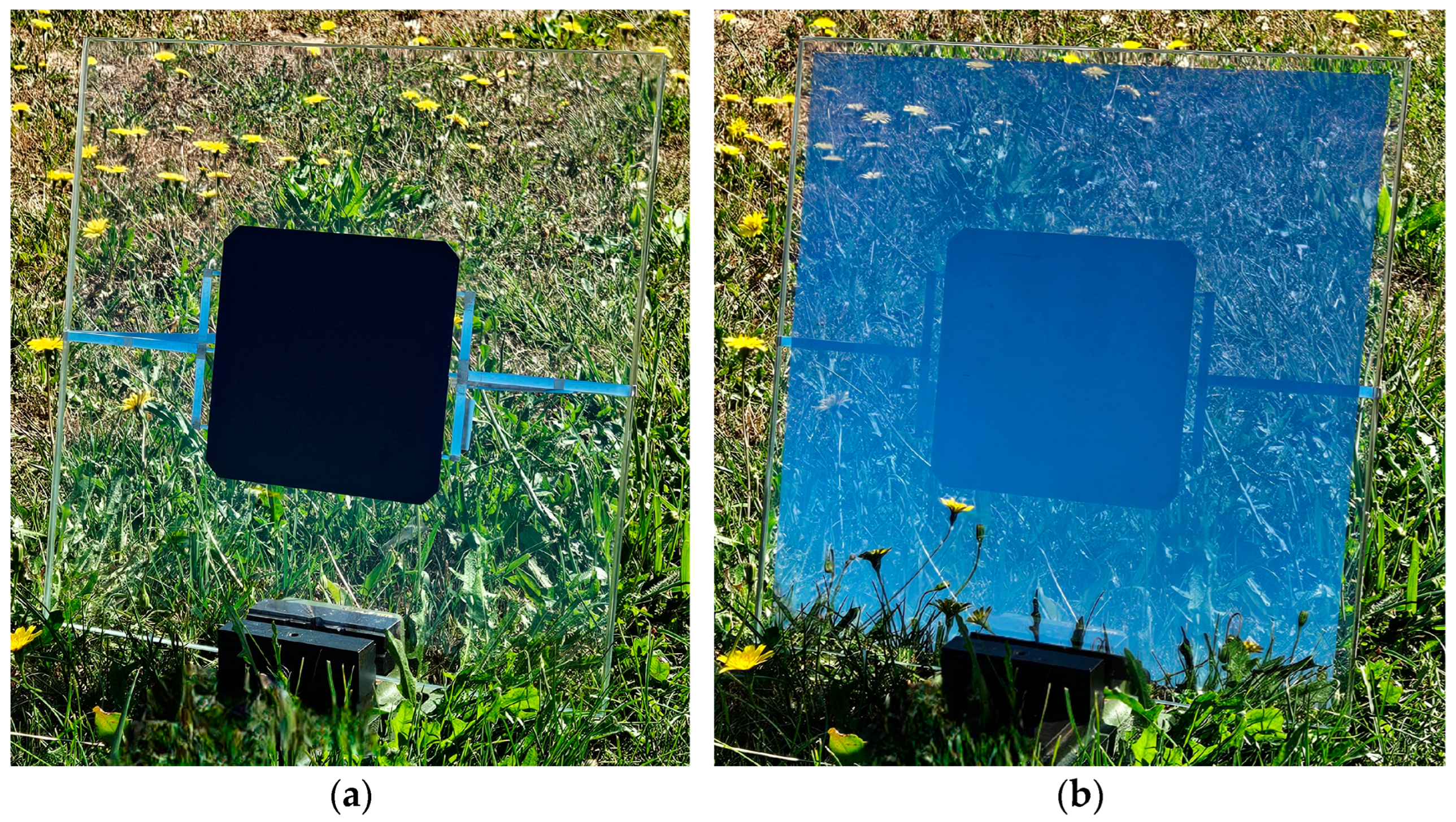
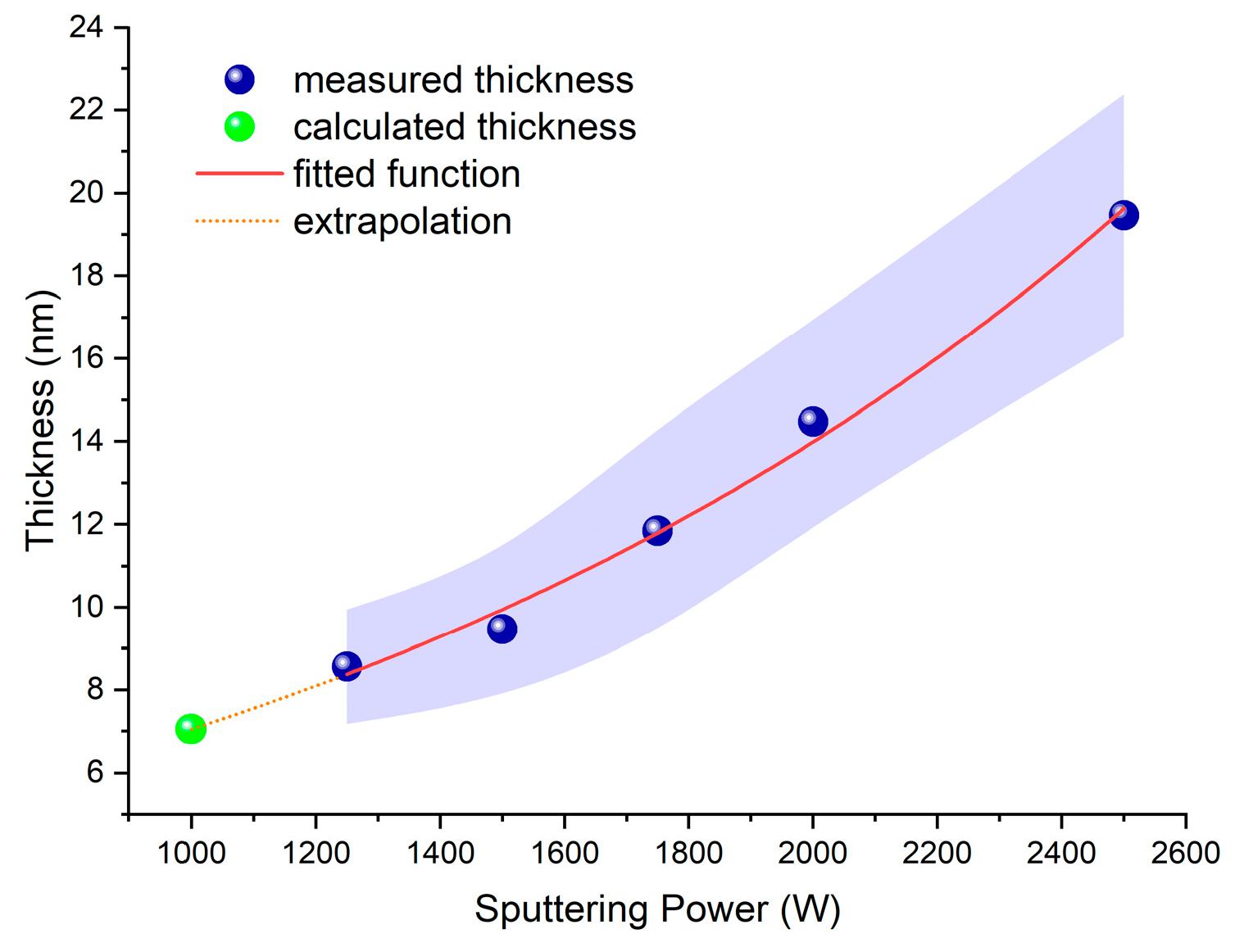
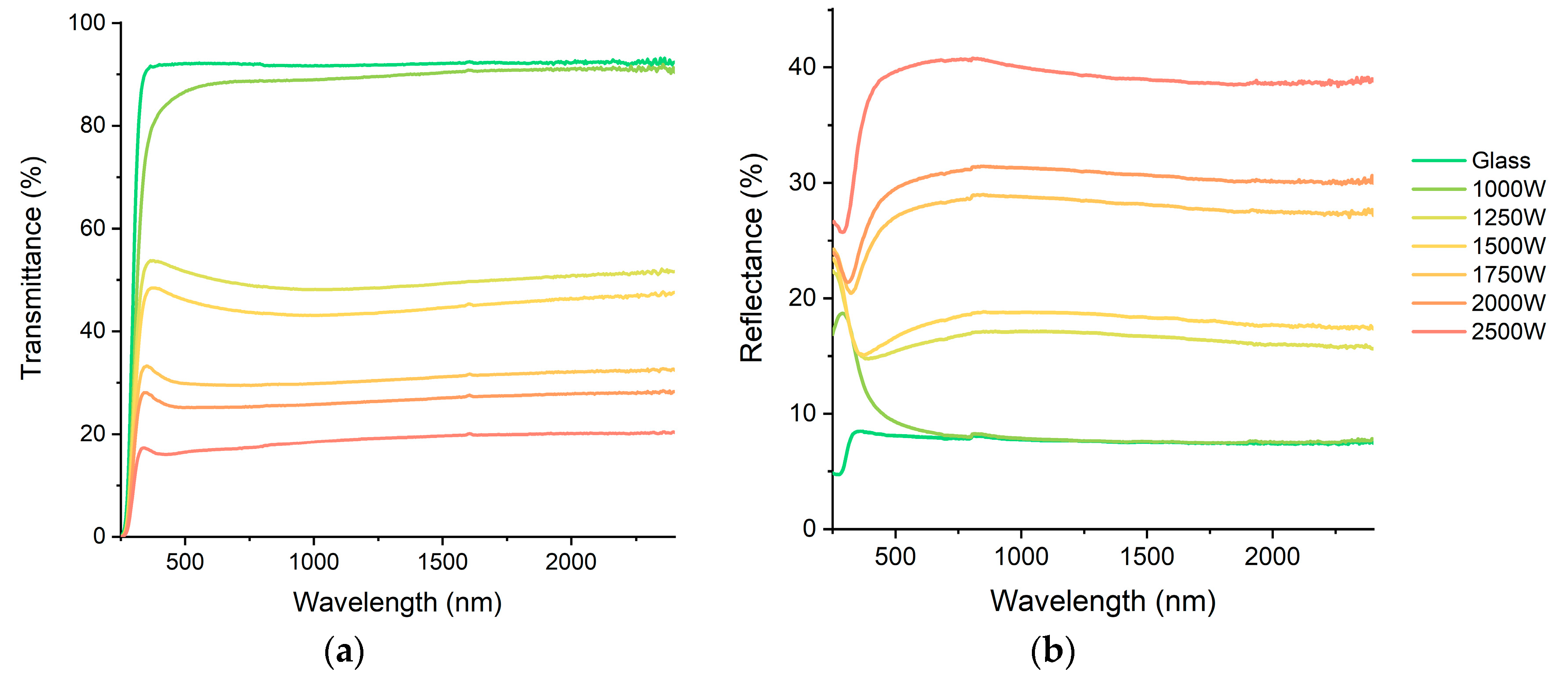
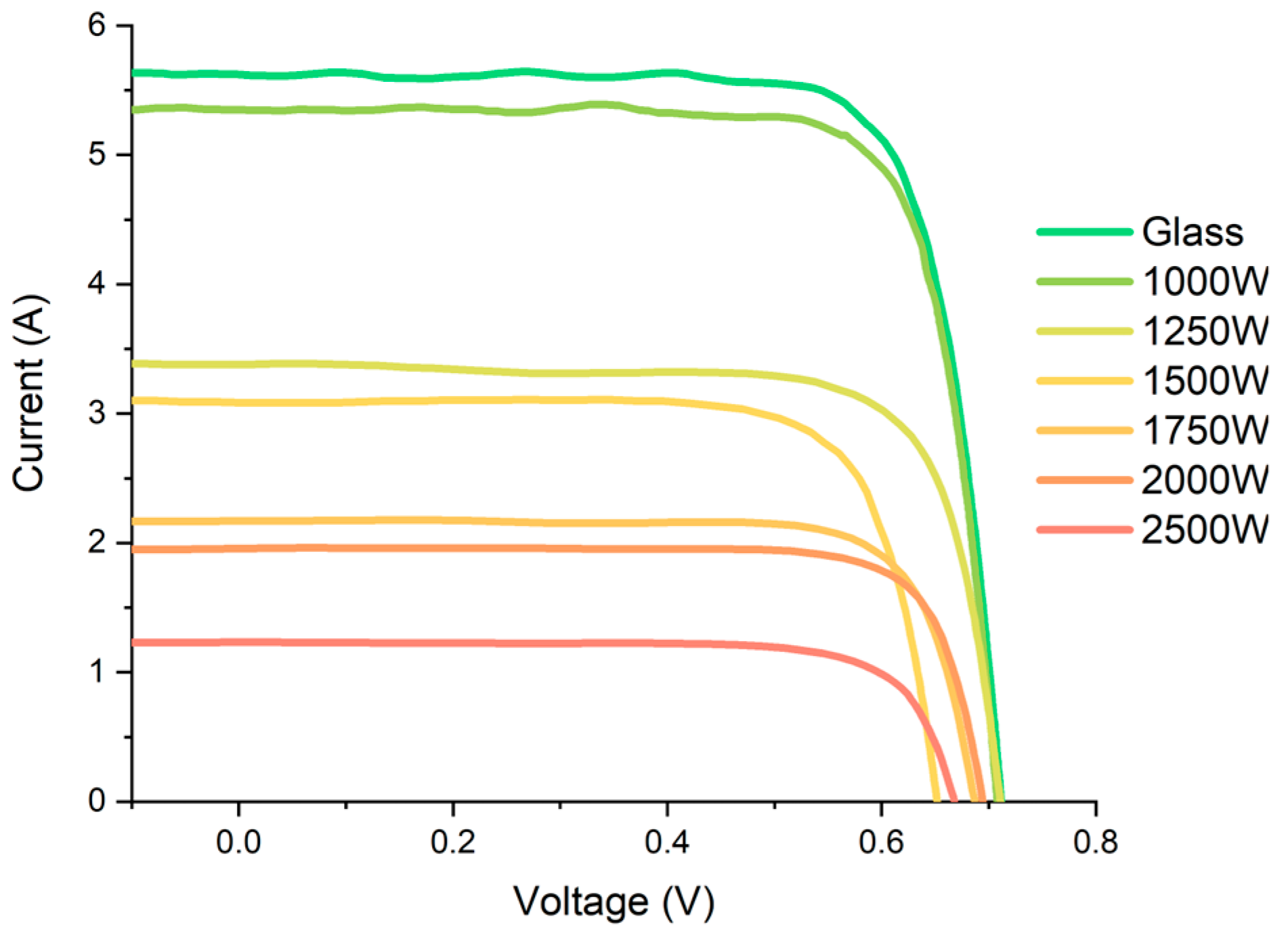

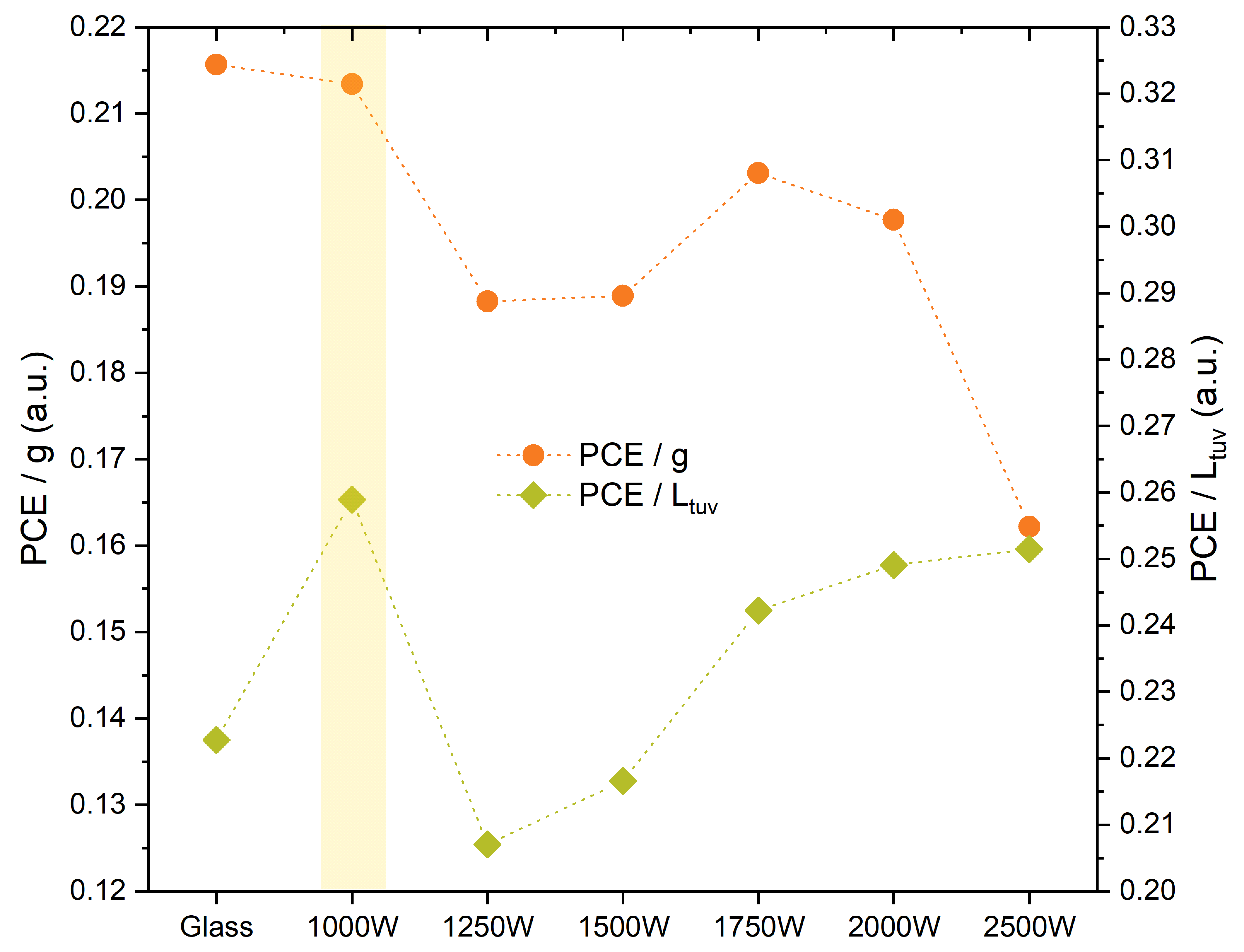
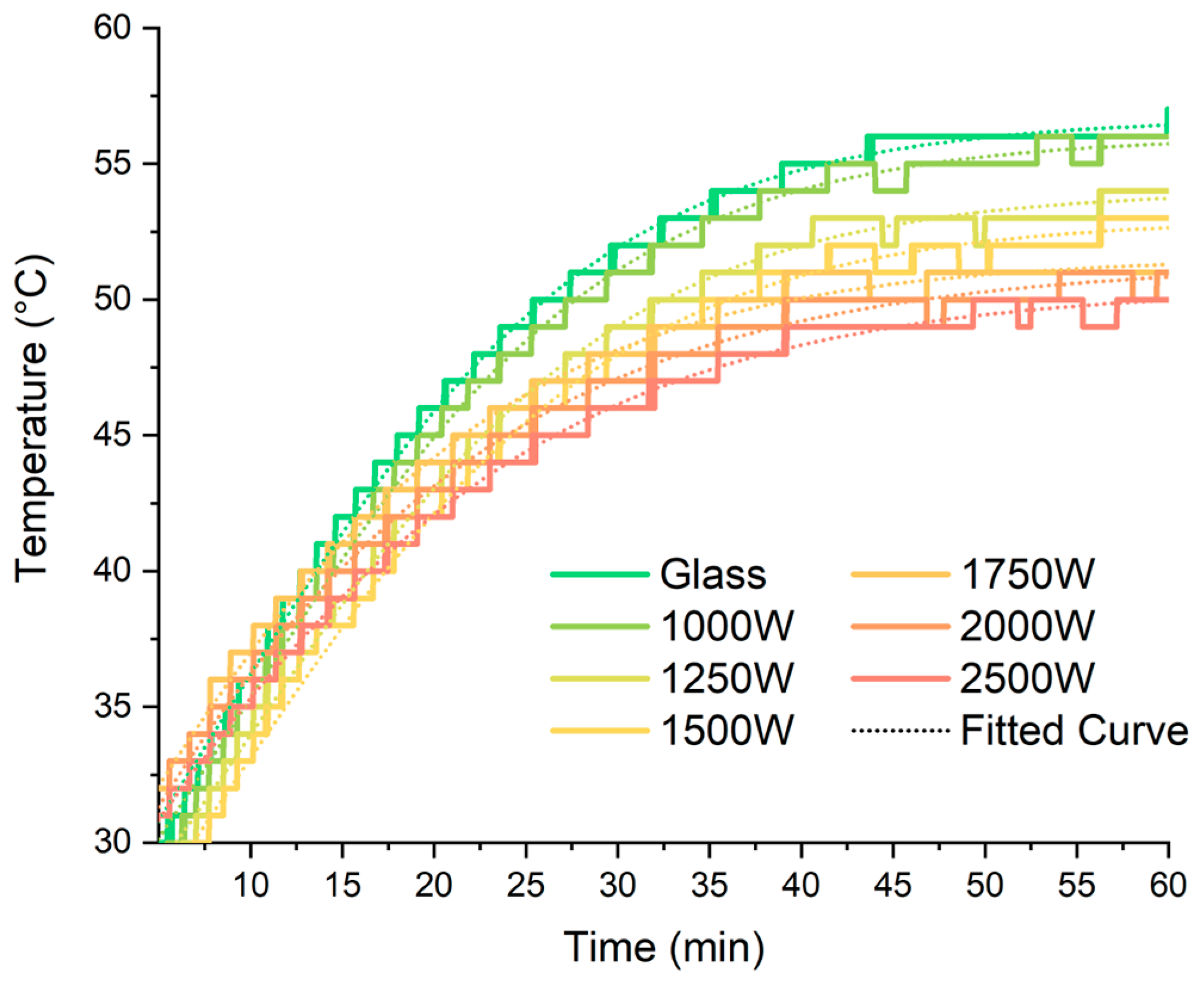
| Sample ID | Lt (%) | Ltuv (%) | g (%) | Lr (%) |
|---|---|---|---|---|
| Glass | 92 | 89 | 92 | 8 |
| 1000 W | 88 | 73 | 88 | 9 |
| 1250 W | 51 | 51 | 56 | 17 |
| 1500 W | 45 | 46 | 52 | 16 |
| 1750 W | 30 | 32 | 38 | 28 |
| 2000 W | 25 | 27 | 34 | 30 |
| 2500 W | 17 | 17 | 26 | 40 |
| Sample ID | Uoc (mV) | Isc (A) | FF | PCE (%) |
|---|---|---|---|---|
| Glass | 712 ± 4 | 5.61 ± 0.02 | 0.773 ± 0.005 | 19.8 ± 0.4 |
| 1000 W | 713 ± 7 | 5.36 ± 0.03 | 0.769 ± 0.017 | 18.8 ± 0.2 |
| 1250 W | 704 ± 6 | 3.12 ± 0.30 | 0.778 ± 0.017 | 10.6 ± 0.9 |
| 1500 W | 651 ± 2 | 3.04 ± 0.08 | 0.775 ± 0.001 | 9.9 ± 0.3 |
| 1750 W | 673 ± 19 | 2.33 ± 0.24 | 0.781 ± 0.006 | 7.8 ± 0.6 |
| 2000 W | 696 ± 6 | 1.91 ± 0.10 | 0.794 ± 0.001 | 6.8 ± 0.4 |
| 2500 W | 668 ± 2 | 1.27 ± 0.06 | 0.777 ± 0.004 | 4.2 ± 0.2 |
| Sample ID | Tmax (°C) | τ (s) | τ−1 (10−3 s−1) |
|---|---|---|---|
| Glass | 56.7 | 611 | 1.64 |
| 1000 W | 56.0 | 608 | 1.65 |
| 1250 W | 54.0 | 619 | 1.62 |
| 1500 W | 53.0 | 635 | 1.58 |
| 1750 W | 51.6 | 706 | 1.42 |
| 2000 W | 51.4 | 812 | 1.23 |
| 2500 W | 50.5 | 847 | 1.18 |
Disclaimer/Publisher’s Note: The statements, opinions and data contained in all publications are solely those of the individual author(s) and contributor(s) and not of MDPI and/or the editor(s). MDPI and/or the editor(s) disclaim responsibility for any injury to people or property resulting from any ideas, methods, instructions or products referred to in the content. |
© 2024 by the authors. Licensee MDPI, Basel, Switzerland. This article is an open access article distributed under the terms and conditions of the Creative Commons Attribution (CC BY) license (https://creativecommons.org/licenses/by/4.0/).
Share and Cite
Kwaśnicki, P.; Augustowski, D.; Generowicz, A.; Kochanek, A. Influence of Ti Layers on the Efficiency of Solar Cells and the Reduction of Heat Transfer in Building-Integrated Photovoltaics. Energies 2024, 17, 5327. https://doi.org/10.3390/en17215327
Kwaśnicki P, Augustowski D, Generowicz A, Kochanek A. Influence of Ti Layers on the Efficiency of Solar Cells and the Reduction of Heat Transfer in Building-Integrated Photovoltaics. Energies. 2024; 17(21):5327. https://doi.org/10.3390/en17215327
Chicago/Turabian StyleKwaśnicki, Paweł, Dariusz Augustowski, Agnieszka Generowicz, and Anna Kochanek. 2024. "Influence of Ti Layers on the Efficiency of Solar Cells and the Reduction of Heat Transfer in Building-Integrated Photovoltaics" Energies 17, no. 21: 5327. https://doi.org/10.3390/en17215327
APA StyleKwaśnicki, P., Augustowski, D., Generowicz, A., & Kochanek, A. (2024). Influence of Ti Layers on the Efficiency of Solar Cells and the Reduction of Heat Transfer in Building-Integrated Photovoltaics. Energies, 17(21), 5327. https://doi.org/10.3390/en17215327









